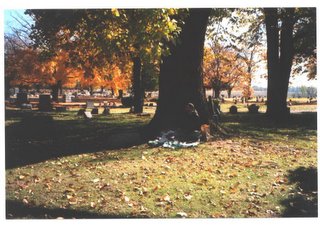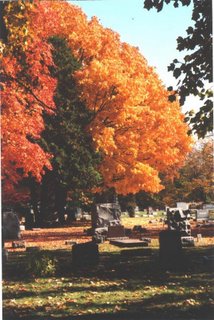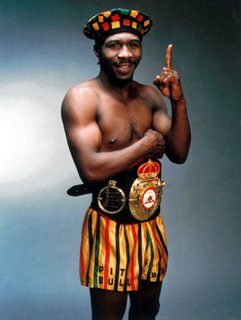


One photo from Lincoln Memorial Gardens near Springfield and two from Oakland Cemetery in Petersburg, IL.
I had some hip pain after the Fat Ass race that set back training for about a week, but was able to get out and do two hours at Farmdale on Sunday without much trouble. Hoping for 3+ hilly hours at Forest Park this weekend--a good physical test. McNaughton in April remains the goal.
Re-watched both volumes of "Kill Bill" this past week. Liked them even better the second time around. One thing I failed to notice previously is that Gordon Liu is in both movies, the head bodyguard of the crazy 88's in I and Pai Mei in II. Gordon Liu of course is the "Shaolin Masterkiller," widely regarded as the best martial arts film ever. There's no doubt it has the best training scenes.
Gatti/Damgaard this weekend. I have to wonder what Gatti has left at age 33, but my calendar is frickin cleared for this one. You have to go back to ancient Rome to see a guy like this. A warrior in the purest sense.
Thursday, January 26, 2006
Lincoln Memorial Gardens and Oakland Cemetery
Posted by
dirt_trail_runner
0
comments
![]()
Wednesday, January 18, 2006
Oba Carr vs. Livingstone Bramble: A Pugilistic Dissertation

My hack tribute to A.J. Liebling:
On October 8, 1991 the young lion from Detroit met the aging former champion in a true crossroads fight for both guys.
Bramble was six years or so removed from his glory days in the mid-80s. In 1984 and ’85 he had decisively beaten America’s favorite champion, Ray “Boom Boom” Mancini. Bramble fabulously played the villainous foil to Mancini’s “golden boy” persona. By employing a “witch doctor” to hex Ray, showing off his cadre of exotic animals, and generally trumpeting his Rastafarian eccentricity, Bramble forged himself a spot as one of the most colorful fighters of the period. Not only that, but the guy could fight.
Employing a style that started behind a high tight-gloved defense, Bramble in his prime would pick off shots and use sharp counterpunching and physical strength to grind down opponents. Against Mancini he used the crafty tactic of switching to lefty, confounding the less slick Ray and allowing Bramble to land his solid lead right hand repeatedly, stopping Mancini in the 14th round of their first fight and earning a unanimous decision in the rematch in Reno some eight months later.
In early 1986 Livingstone defended the WBA lightweight championship he’d wrested from Mancini against slick Tyrone “Butterfly” Crawley, wearing down the challenger and stopping him in the 13th. This was the apex of Bramble’s career. After the Crawley fight things declined for the “Rastaman.” In September of 1986, “Chapo” Rosario split open Bramble’s eye (he claimed he was thumbed), stopping the champion in the 2nd and taking the belt. Bramble followed that tough loss with a draw and then a loss to Freddie Pendleton in a USBA title bid. He flirted with the top 10 in the jr. welter division but couldn’t crack through into the upper echelons. Going into the Carr fight, Bramble was 2-3 in his last five with wide points losses to Santos Cardona, Tony Martin (a fight he was winning before separating a shoulder), and Carl Griffith.
The 31-year old former champ looked to be a perfect stepping stone for an up-and-coming prospect, a name guy who by all recent accounts wouldn’t pose much of a threat to an undefeated record.
Oba Carr was a fresh 19-year old out of the famous Kronk gym, a fluid boxer with great speed and an unblemished 20-0 record, looking to put on a show in front of his hometown Detroit fans and move closer towards the inevitable world title. In only his ninth fight he KO’d solid, but by then faded Anthony Fletcher, and Carr was coming off wins over capable journeymen Ramon Zavala and 21-4, Bernard Grey. The stage was set for one of boxing’s time tested classic matchups: the aging former champ vs. the sure shot future champ.
The Fight:
Bramble came out in his typical eccentric fashion, sporting short dreadlocks and flashy pink trunks. Carr, in the traditional Kronk gold, seemed a bit awed by the occasion during the introductions.
Round 1: Bramble started off looking to test Carr early, as a veteran should, walking forward behind his trademark tight-gloved defense. Carr backpedaled, flicking out the occasional jab. Just 1:15 into the opening stanza, Professor Livingstone served up a pop quiz to the young pupil, leaping in with a perfectly timed long left and immediate straight right, both catching Carr flush and dropping him onto his Kronk lettering. Oba beat the count and jumped on his bicycle. Bramble, sensing a quick kill, swarmed in and 30 seconds later landed a chopping right that sent the young fighter’s knee momentarily to the canvas for knockdown number two. Bramble stalked for the final minute but failed to put Carr away. The prospect had passed his first unsolicited test.
Round two saw Carr moving well while the older boxer tried to walk him down. Oba moved laterally and potshotted with quick combos, most blocked by the Rastaman’s gloves, but doing enough to win the round.
The Kronk fighter gained some confidence back in the third, negating much of Bramble’s aggression with his jab and constant movement. He did what a young pugilist is supposed to do against a slightly over-the-hill opponent, use the less abused reflexes and legs to pile up points.
While the young lions have the legs, the old have something that can be even more deadly in the jungle—experience. Veterans know how to be patient in the ring, how to draw up a blueprint, lay the foundation, and persist until the structure starts to take shape. Bramble was a veteran’s veteran, and his relentlessness paid off at 1:00 of the fourth, when a solid left hook landed, brining Carr off his bike and forcing the youngster to tie up. Oba tried moving out of danger, but the astute viewer could see that some of the youthful juice had been sapped from his body. A snapping uppercut at the end of the round sealed it for Bramble.
The young student turned the proverbial tables on his teacher in round five. Sometimes our elders are asked to prove that their wisdom is well earned and legitimate:
“Come on old man, what do you know anyway?”
Oba Carr asked that question and was indulged with the answer.
The early portion of the round was more of the same, Bramble trying hooks and looping rights while Carr moved, jabbing as usual. However, a subtle change had taken place. Carr was now stopping for just a slight moment every few jab sequences to load up a big left hook. One of those hooks threw its hand up in the back of the class and tagged the teacher at 1:20 of the round.
The exquisitely timed left hook sent Bramble’s legs wobbly, arms flailing, forcing him immediately back into the ropes. Carr turned hunter and pounded away on the former champ, landing several consecutive left-right one-twos and nearly decapitating his stationary opponent with a crunching straight right on the point of the jaw. Bramble staggered to the center of the ring while the hometown favorite ripped off unanswered salvos, begging the question over and over,
“Show me what you know, old man.”
And yet Bramble would not fall. You see, the good professor had been here before, in the middle of a firefight, heart and soul splayed open and exposed for scrutiny. Ah yes, he’d been privy to the answer sheet and knew, knew well that the experience of years between the ropes could sometimes trump those young legs and flashy hands.
After a minute of continuous, one-sided brutality, Carr suddenly looked winded. Had he punched himself out? Bramble flashed him a knowing looking and nodded his said, the expression laying it out there where words can’t go:
“O.K. son, satisfied with your answer? Now we fight.” Jungle style.
With just 30 seconds left in the round, Oba was dog tired and fell in, trying desperately to tie up the older fighter. From some deep reservoir of heart, Bramble started firing lefts and uppercuts, driving Carr into his own corner, his handlers imploring over the din of 10,000 screaming fans to hold on, to stay on his feet. Carr finished the round standing. Bramble finished it punching.
A classic round of fistic warfare. Carr’s assault earned him a 10-8 round, but Bramble’s survival earned him the advantage in the contest, much of the will drained from Oba after being unable to get the knockout.
Round six saw a reversion back to the pattern of Bramble as the aggressor with Carr playing matador. Yet, Oba’s legs just weren’t as fresh, allowing Livingstone to get in range to land much more often.
That pattern persisted in rounds seven and eight. Bramble employed another veteran trick of increasing punch output in the last minute of a round to seal it on the cards, chopping Carr with a right hand over the jab in the 7th and rocking him to close the 8th.
Carr gave away round nine on my card by continuously falling in, abandoning the left hook, and allowing himself to be out-hustled on the inside.
Bramble landed a clean, crisp right hand a minute into round ten and outworked his opponent down the stretch to punctuate a great performance few thought he could muster at this stage of his career.
We all know that the nature of boxing is that it doesn’t always reward deserving fighters with wins. The professors of the game know this risk well. I scored the fight 96-91 for Bramble, but the Michigan (read: hometown) judges had, maybe predictably, different ideas.
The decision read: 95-93 Bramble, 96-93 Carr, 95-94 Carr. The split decision went to the Kronk fighter and was lustily booed by Oba’s home Palace crowd. The post-fight interview told more than the judges’ scorecards, as a sheepish Carr seemed almost apologetic, stating quietly:
“I tried my best against a 31-year old man—It’s good, I think.” Not exactly the words of an assured victor.
Bramble wore his ever present ear-to-ear grin, stating:
“This loss won’t affect the Pit Bull. I’m happy with my performance and I know where I’m at in the game.”
Prof. Bramble knew he had imparted some lessons. The good ones always know the score.
Livingstone was unable to parlay his performance into a big money fight, losing a lopsided decision to Charles Murray just two months later and going 9-19-1 in a career that would sadly last in journeyman fashion with losses to great fighters such as Buddy McGirt, Kostya Tszyu, Roger Mayweather, Rafael Ruelas, and others to lesser named fringe conteders. Bramble never did rise again to the level of the Carr fight, coming closest in a good battle with Ricky Meyers, but losing another narrow decision.
Carr also floundered after the controversial win, spending the next three years fighting club fighters, until finally getting a shot at, unfortunately for him, a prime Felix Trinidad’s IBF welterweight title. Oba would account himself well, actually scoring a knockdown in the 2nd round, before being dropped three times and stopped by Tito in the 8th. Carr fought on until 2002, never again approaching world class status yet finishing his career at a respectable 54-6-1.
Although neither man ever elevated to the top of the sport after their fight, for one night in the autumn of 1991 the professor and the student wowed the boxing world with a drama worthy of any English literature graduate seminar.
Posted by
dirt_trail_runner
173
comments
![]()
Monday, January 09, 2006
Fat Ass 50k McNabb, Illinois Version
Fat ass?? Yeah maybe, but so what. I can still run, ok maybe run/walk/shuffle a bit here and there.
The whole concept behind the Fat Ass races is a low key event during the winter season, I assume to burn off some of the holiday excess. Yesterday we decided to sample this no frills exercise in exercise. "No shirts, no aid, no wimps, run as much or as little as you would like" the race description reads. You probably won't find wimps in a 50k and typical January temps would keep even the slightly wimpy home, but yesterday was more like late March in Central Illinois. Conditions could not have been better, starting temps in the upper 30s, warming into the 50s by afternoon. The tiny burg of McNabb is the site of this race, starting at the jr. high and looping 1/2 mile out and back to get the first mile of the 50k in then down a more scenic 5 mile out and back course on 75% paved, 25% dirt road through a nice wooded, rural area with slightly rolling hills.
Our plan was to do a 10/2 run/walk strategy, taking it easy and going for 3 hours. There are aid stations at the start, an unmanned table at 2 miles and a manned station at the turnaround. Amazingly all the aid is paid for by the race director and a few donations. There is even the option of free beer after the race at a local joint down the road. How cool is that? I felt pretty good the whole way, with the exception of some slight hip soreness after about 2:20. We ended up doing 15 or so miles in 3:00, a good training run and one of the longest I've done off of trails in a long while, making it a beneficial mental exercise to break from the normal routine of long, slow single track running. The whole race had this sort of underground feel and a friendly atmosphere, not to mention the scenic beauty of rural Putnam County. This fat ass, for one, was content.
Posted by
dirt_trail_runner
1 comments
![]()
Wednesday, January 04, 2006
Harmony of Fighting
I recently read that "music is a conduit for the divine." My belief is that music can touch areas of the spirit that are undefinable and not readily articulated by human verbiage.
Joyce Carol Oates tells us this mystic connection is also found in prizefighters. The pugilist senses the otherworldly through the outward physical exhibition of pure inward human soul.
James Toney's old trainer, septugenarian Bill Miller stated in an interview that:
"Charlie Parker is to music as Ray Robinson was to boxing. When you listen to Charlie Parker you're listening to a master. You heard it all there, Parker expressed with his instrument , where Robinson expressed it with his movement, his hand speed, and agility. They were closely related, told you a story."
Miller knows.
At its most profound depths there is a musical poetry to boxing, the backbeat metronome of the jab landing flush, the free form flow of gliding footwork, cacophonous thump of a sharp left hook, a perfectly hit high note. A beautiful boxer like Sweet Pea Whitaker was Parker-like in his ability to improvise in a split second, to fill open space with the expressivee flow of physical movement, bringing structure into where moments earlier there only void. Like jazz, the music of boxing can be an acquired taste. By surrenedering your spirit to the music, to the physical poetry of the fight, we get a small taste of the sublime. Miller is right, the message is there for the taking, we need only listen for it.
Posted by
dirt_trail_runner
2
comments
![]()
